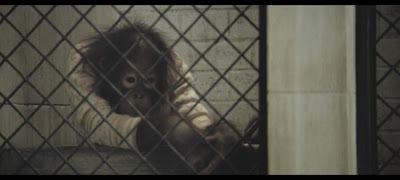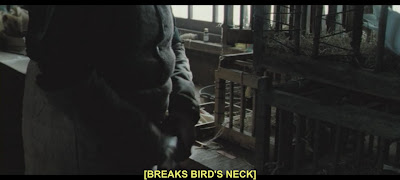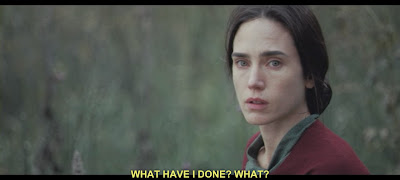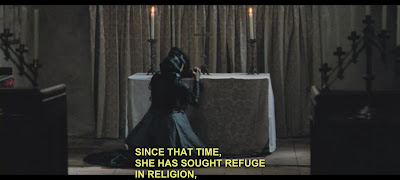| (Gilles Quispel) |
Creation is The Shining masquerading as a biopic. The first scene in the film is of his Daughter having her picture taken; this is Mark LeClair's crucifixion of the Moon by the camera shutter (Shutter Island). Paul Bettany (Charles Darwin) is a red-haired Jack Torrance the Demiurge; he wishes to overthrow God and make himself like the Most High. Jennifer Connelly is Wendy Torrance as World-Soul; she tries to keep the spiritual connection in place but she is tending towards the Irrational and really needs to Eat Something. Haunted by the ghost of his dead Daughter (= the Shining twins), he's going to do his own Writing and build a Tower while Jenny suffers in silence (it's a sexless marriage). The whole of his mechanistic creation depends on Dead Birds; it's the constant theme.
| (Quispel) |
Proserpina, forgetful of her parent’s commands, is represented as venturing from her retreat . . . for oblivion necessarily follows a remission of intellectual action, and is as necessarily attended with the allurements of desire. . . . for she rambles from home for the purpose of gathering flowers; and this in a lawn replete with the most enchanting variety, and exhaling the most delicious odors. This is a manifest image of the soul operating principally according to the natural and external life, and so becoming effeminated and ensnared through the delusive attractions of sensible form. (Thomas Taylor)
Hence, by an immoderate attachment to this unsubstantial mockery and gliding semblance of the real soul, such an one becomes, at length, wholly changed, as far as is possible to his nature, into a vegetive condition of being, into a beautiful but transient flower, that is, into a corporeal life, or a life totally consisting in the mere operations of nature. Proserpina, therefore, or the soul, at the very instant of her descent into matter, is, with the utmost propriety, represented as eagerly engaged in picking this fatal flower; for her faculties at this period are entirely occupied with a life divided about the fluctuating condition of body. (Taylor)
After this, Pluto, forcing his passage through the earth, seizes on Proserpina, and carries her away with him, notwithstanding the resistance of Minerva and Diana. They, indeed, are forbid by Jupiter, who in this place signifies Fate, to attempt her deliverance. (Taylor)

Pluto hurries Proserpina into the infernal regions: in other words, the soul is sunk into the profound depth and darkness of a material nature. A description of her marriage next succeeds . . . For the soul through her union with a material body becomes an inhabitant of darkness, and subject to the empire of night; in consequence of which she dwells wholly with delusive phantoms, and till she breaks her fetters is deprived of the intuitive perception of that which is real and true. (Taylor)
“Life is more of a dream than a reality.” Men are utterly the slaves of sense, the sport of phantoms and illusions. We now resemble those “captives chained in a subterraneous cave,” so poetically described in the seventh book of The Republic; their backs are turned to the light, and consequently they see but the shadows of the objects which pass behind them, and “they attribute to these shadows a perfect reality.” (Cocker’s Greek Philosophy)
The subject–object problem, a longstanding philosophical issue, is concerned with the analysis of human experience, and of what within experience is "subjective" and what is "objective." It arises from the premise that the world consists of objects (entities) which are perceived or otherwise presumed to exist as entities, by subjects (observers). This results in questions regarding how subjects relate to objects, one of which is called the "knowing subject". . . . The subject–object problem is twofold: firstly, there is the question of "what" is known. This dilemma goes back at least as far as Descartes, and arises from his skepticism that an evil demon might, conceivably, be controlling his every experience.
 |
| Law of falling bodies, 32 feet per sec per sec |
In quantum mechanics, wave function collapse (also called collapse of the state vector or reduction of the wave packet) is the phenomenon in which a wave function—initially in a superposition of several different possible eigenstates—appears to reduce to a single one of those states after interaction with an observer. In simplified terms, it is the reduction of the physical possibilities into a single possibility as seen by an observer.
According to the Pagan sages, we are each made up of a mortal eidolon and the immortal Daemon. If we are alive to our personal identity as the eidolon, we are dead to our eternal identity as the Daemon. . . . In the Gnostic myth Exegesis of the Soul, Sophia (the soul) becomes lost looking for reflected light in the world created by the demiurge (the eidolon or lower self). (Freke & Gandy)


First [was there] Mind the Generative Law of All;
Second to the Firstborn was Liquid Chaos;
Third Soul through toil received the Law.
Wherefore, with a deer's form surrounding her,
She labours at her task beneath Death's rule.
Now, holding sway, she sees the Light;
And now, cast into piteous plight, she weeps;
Now she weeps, and now rejoices;
Now she weeps, and now is judged;
Now is judged, and now she dieth;
Now is born, with no way out for her; in misery
She enters in her wandering the labyrinth of ills.
Their chief is blind; because of his power and his ignorance and his arrogance he said, with his power, "It is I who am God; there is none apart from me." When he said this, he sinned against the entirety. And this speech got up to incorruptibility; then there was a voice that came forth from incorruptibility, saying, "You are mistaken, Samael" - which is, "god of the blind." (The Hypostasis of the Archons )

Such, indeed, is the wretched situation of the soul when profoundly merged in a corporeal nature. She not only becomes captive and fettered, but loses all her original splendor; she is defiled with the impurity of matter; and the sharpness of her rational sight is blunted and dimmed through the thick darkness of a material night. The reader may observe how Proserpina, being represented as confined in the dark recess of a prison, and bound with fetters, confirms the explanation of the fable here given as symbolical of the descent of the soul . . . (Taylor)
When she was unable to assuage her love, she poured out her light upon the earth . . . "the Holy Land of Adamantine." Since that day, all the authorities have honored the blood of the virgin. And the earth was purified on account of the blood of the virgin. But most of all, the water was purified through the likeness of Pistis Sophia, who had appeared to the prime parent in the waters. (On the Origin of the World)
When they get to the house, He tells them not to cry because she is not dead and they laugh at Him. Was she dead? Yes. The text says, “Her spirit returned.” Why does He say she is only asleep? Because He knew it was not permanent. She wasn’t going to stay dead. Jesus says the same thing with Lazarus, the disciples misunderstand and he corrects them saying, “no, he is really dead.” Sleep is a euphemism for “temporal” death. (Bible.org)
I stare at my reflection in the mirror
Why am I doing this to myself?
Losing my mind on a tiny error
I nearly left the real me on the shelf
No, no, no, no, no
Don't lose it all in the blur of the stars
Seeing is deceiving, dreaming is believing











































































































































































